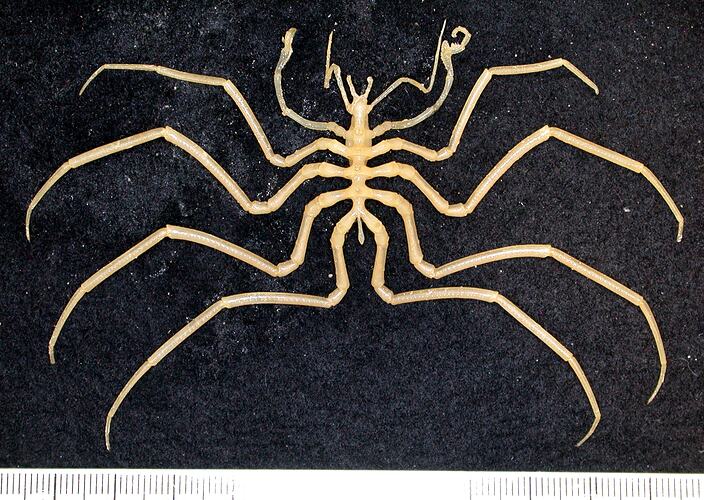General Description
One of the largest sea spiders of its genus, Ascorhynchus cooki has eight legs, though the first pair is comparatively small. They can reach a leg span of 178 mm.
Biology
Members of the genus Ascorhynchus are unusual in that they spend most of their life buried amongst the sand grains and sediments beneath the sea floor. Specimens placed on the surface of the sand quickly bury themselves by shuffling their legs. Ascorhynchus cooki is one of seven giant species belonging to this genus. Shallow water representatives are much smaller than this specimen with leg spans up to about 40 mm and can be found in sandy or silty areas of Bass Strait and Port Phillip. Generally in sea spiders the males carry eggs on their underside, using a pair of appendages called ovigers. In most sea spiders the eggs are individually attached to the ovigers. In this genus the eggs are embedded in a gelatinous ribbon-like mass wrapped around both ovigers. This may prevent individual eggs being dislodged as the male moves through the sediment. The mouth is found at the tip of the proboscis. Usually a sea spider's proboscis points forward but in this species it is carried beneath the spider facing to the rear so that it is being 'dragged' rather than being 'pushed'. This might be a more efficient way of moving through the sediment.
Distribution
Southwest Pacific, from off the Cook Strait to southwest of Macquarie Island.
Habitat
Marine deep sea troughs.
More Information
-
Animal Type
-
Fast Fact
Named for the famous explorer Captain James Cook.
-
Brief Id
A large sea spider that lives buried beneath the sea floor.
-
Maximum Size
178 mm
-
Habitats
-
Endemicity
-
Commercial
No
-
Depths
Deep ( > 30 m)
-
Water Column Locations
On or near seafloor
-
Taxon Name
-
Scientific Author
Child, 1987
-
Common Name
Burrowing Sea Spider
-
Phylum
-
Subphylum
-
Class
-
Family
-
Genus
-
Species Name
cooki


